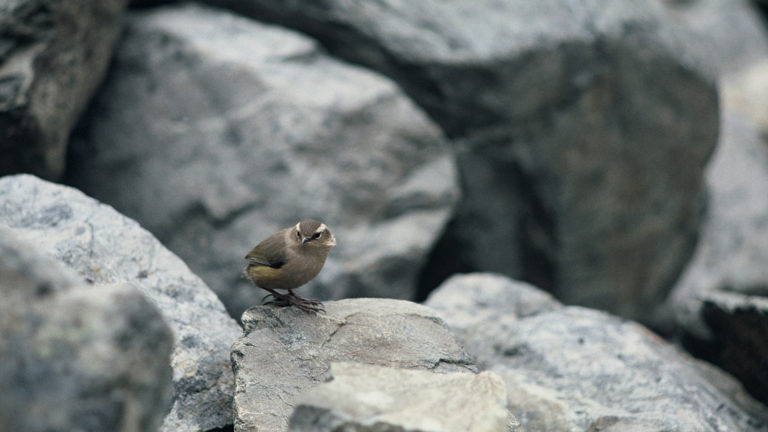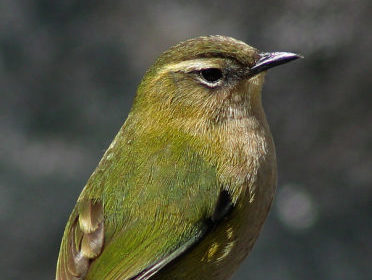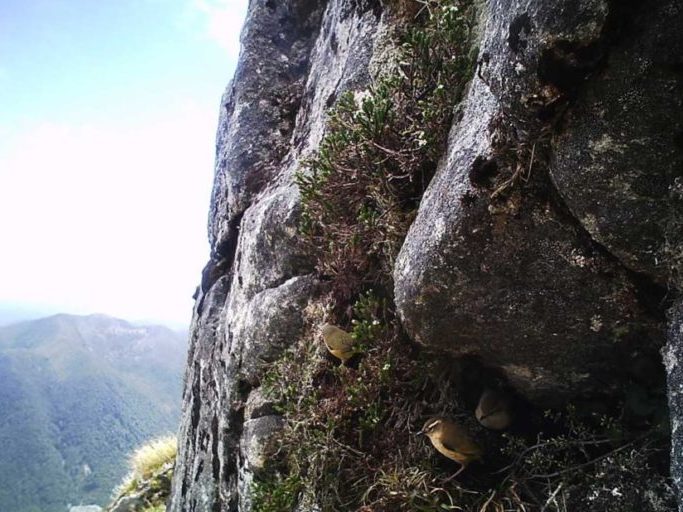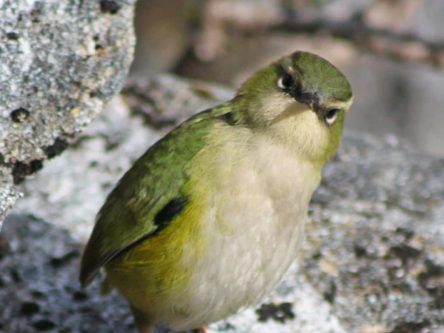Many people will never see a rock wren. Not everyone makes it up to the alpine and sub-alpine zone and the tiny rock wren doesn’t venture below the treeline. That makes it our only true alpine bird. (Kea and other alpine-living birds do sometimes come down to lower altitude forest, especially in winter.)

Rock wren love feathers. Leaving one or two feathers lying around is a trick that scientists sometimes use to track rock wrens to their nest. Possibly feathers are hard to come by in the mountains and they’re soft and warm – perfect for nest-lining.
Back in the 1930s, ornithologist Guthrie-Smith recovered 791 feathers from one nest. Most feathers were from weka, but there were also some from kiwi, kakapo, kea, and kereru. How do you know if there are endangered kakapo in an area? One way is to check the local rock wren nests to see if there are any kakapo feathers.
The New Zealand rock wren (also know as pīwauwau, piwauwau, mātuitui, matuitui, South Island wren and tuke), is very small bird and is found only in the Southern Alps of the South Island. Pīwauwau means “little complaining bird”. Tuke means “twitch”, after its bobbing motion.

The pīwauwau has a short tail, rounded wings and long legs and toes. The male is dull green above and grey-brown below with yellow flanks, and the female is slightly plainer, mainly olive-brown. They breed in spring and summer and construct a thickly lined and fully enclosed woven nest at ground level within a natural cavity, with an entrance tunnel.
The average clutch size is 3, with only one brood reared in a season. Both adults incubate the eggs and care for the young, but only the female incubates the eggs and brood chicks at night. The feather-lined nest is well insulated and can be as warm as 30 degrees, when outside it is below freezing.
Being cavity nesters makes pīwauwau very vulnerable to predation by mice and stoats. In areas where there is predator control, around 85% of nests are successful in fledging young. In areas where there is no predator control, nesting success is 0 – 30% and populations are at risk of extinction. Stoats are particularly well-adapted for cold temperatures and intermittent food sources.
At present all rock wren habitat is above the altitudinal limit for ship rats but this may change with global warming and cause an even greater predation threat. The conservation of this species was changed from nationally vulnerable to nationally endangered in 2013.
Rock wrens are ground feeders, feeding among low scrub, open scree, and rockfalls. They mainly eat insects (especially moths, moth larvae, flies, beetles, scale insects) and spiders. Fruit from Gaultheria and Coprosma spp. are also eaten. They tend to hop rather than fly and, when stationary they bob vigorously, flicking their wings. Their voice is a high pitched three note call and a ‘whirring’ call.
Tiny, long-legged rock wrens typically spend most time hopping and flitting through the alpine boulder fields they inhabit, calling intermittently to others. Foraging birds will occasionally disappear amongst large rocks or into the surrounding dense alpine shrubbery.

They’re poor fliers and when they do fly, flights are short and close to the ground. They rarely fly more than 2 metres off the ground or for distances of more than 30 metres, suggesting they’re a sedentary species with poor dispersal ability. Maximum dispersal is thought to be about 0.5 kilometres.
Even in deepest winter remain in the alpine zone. Being tiny birds (males 16 grams, females 20 grams), they have a high body surface area to volume ratio – which is definitely not the ideal body type for minimising heat loss. So how do rock wrens survive the freezing temperatures?
Rock wrens seem to shelter and forage in rockfalls beneath the snow layer and on rocky bluffs where snow has not collected. They may even have the ability to lower their body temperature with some research suggesting they may have a period of semi-hibernation or torpor.
The New Zealand wrens (Family Acanthisittidae) are an ancient and endemic lineage that up until 1000 years ago included 7 species in 5 genera, including the rock wren and rifleman. Subfossil remains suggest before Polynesian settlement the pīwauwau was also found in lowland forest and in the North Island. Their relatives, the North Island stout-legged wren and South Island stout-legged wren were widespread, common and were completely flightless. The long-billed wren was also flightless but less common in the fossil record, and much like rock wren lived primarily in the sub alpine scrub and tussock at altitude.

The two species of stout-legged wren and the longbilled wren were unable to survive in the presence of Pacific rats and were extinct soon after Polynesian settlement. Recently a possible prehistoric 8th species was discovered. It is thought to date from the early Miocene and appears to be from a sister taxa to the rifleman. It is only known from 4 fossils at one site near St Bathans in central Otago.
Today only the rock wren and the rifleman remain from that ancient family. The bush wren has been considered extinct since 1972.
There is little alpine habitat suitable for rock wren on our predator-free islands, but in 2008–2010, a total of 40 rock wrens were translocated to Secretary Island, an 8140 ha rodent-free island in Fiordland, the third-tallest island in New Zealand. In 2010 a survey located 12 unbanded rock wrens, indicating they were successfully breeding, making it the first successful translocation of rock wren.
Pīwauwau can live for at least 6 years.

